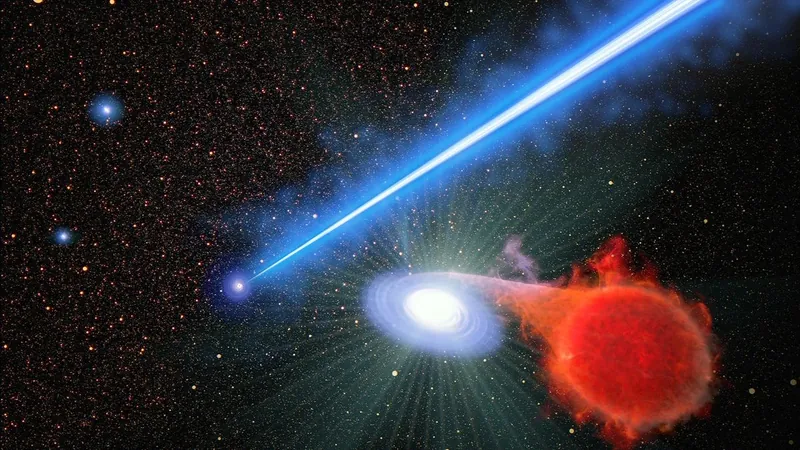
Cosmic Catastrophe: Black Hole 'Blowtorch' Turns Nearby Stars into Explosive Novas!
2024-09-27
Astronomers' Groundbreaking Discovery
Astronomers using the Hubble Space Telescope have made a groundbreaking discovery: a colossal "blowtorch-like" jet emanating from a supermassive black hole is wreaking havoc on nearby stars, causing them to explode in a phenomenon known as novas.
Details of the Jet
The intense jet of superheated plasma stretches an astonishing 3,000 light-years and is spewing forth from a black hole that boasts a staggering mass of 6.5 billion times that of our sun, nestled in the heart of the galaxy M87. This extraordinary finding raises alarming questions about the dynamics of black holes and their effects on star systems in close proximity.
Implications of the Discovery
Getting caught in this beam would spell disaster for any cosmic object in its path. Even stars situated nearby seem to be under siege; recent observations indicate that these superheated emissions are triggering explosive eruptions in nearby star systems. However, the mechanics behind this intriguing phenomenon continue to elude scientists.
Insights from Researchers
Lead author Alec Lessing, an astrophysicist at Stanford University, expressed both excitement and frustration about the findings: "We don't know what's going on, but it's just a very exciting finding. This means there's something missing from our understanding of how black hole jets interact with their surroundings." The team's findings were published on August 14 on the preprint server arXiv.
What Makes this so Remarkable?
Supermassive black holes typically dominate the centers of galaxies, methodically consuming the surrounding matter before ejecting massive energy jets at mind-boggling speeds. This dynamic feedback plays a critical role in shaping galaxy structures. As matter nears a black hole, it heats up, emitting light far brighter than anything we can detect from ordinary stars. Occasionally, these black holes release energy jets that can extend across entire galaxies.
Intriguingly, the Hubble observations have revealed that there are double the number of novas erupting in star systems located near the M87 jet compared to those found in the broader galaxy. Novas typically arise in binary star systems when a white dwarf steals hydrogen from its companion star, leading to an explosive release of energy.
The researchers posit that the black hole's powerful jet may be influencing these star systems in unexpected ways. Lessing suggested, "Maybe the jet somehow snowplows hydrogen fuel onto the white dwarfs, causing them to erupt more frequently." He further noted that the process could involve pressure from the jet's intense light, potentially increasing the rate of hydrogen transfer to the white dwarfs, thereby accelerating the eruptions.
Moreover, another theory put forth involves the possibility that jet material is being captured by the companion stars in binary systems, resulting in an overflow of hydrogen fuel onto the white dwarfs.
What's Next?
To unravel the mystery, astronomers will need to conduct direct observations of star eruptions around cosmic jets, a challenging task given the difficulties of observing such distant objects. However, with novas occurring in M87 at a rate of approximately once a day, the opportunity for groundbreaking discoveries remains tantalizingly close.
This research not only sheds light on the violent interactions between black holes and their celestial neighbors but may also alter our understanding of stellar evolution in the cosmos. As we delve deeper into these mysteries, we may very well be on the brink of uncovering the true nature of black hole jets and their dramatic impacts on the universe. Keep your telescopes pointed towards M87—this cosmic drama is just beginning!


 Brasil (PT)
Brasil (PT)
 Canada (EN)
Canada (EN)
 Chile (ES)
Chile (ES)
 España (ES)
España (ES)
 France (FR)
France (FR)
 Hong Kong (EN)
Hong Kong (EN)
 Italia (IT)
Italia (IT)
 日本 (JA)
日本 (JA)
 Magyarország (HU)
Magyarország (HU)
 Norge (NO)
Norge (NO)
 Polska (PL)
Polska (PL)
 Schweiz (DE)
Schweiz (DE)
 Singapore (EN)
Singapore (EN)
 Sverige (SV)
Sverige (SV)
 Suomi (FI)
Suomi (FI)
 Türkiye (TR)
Türkiye (TR)